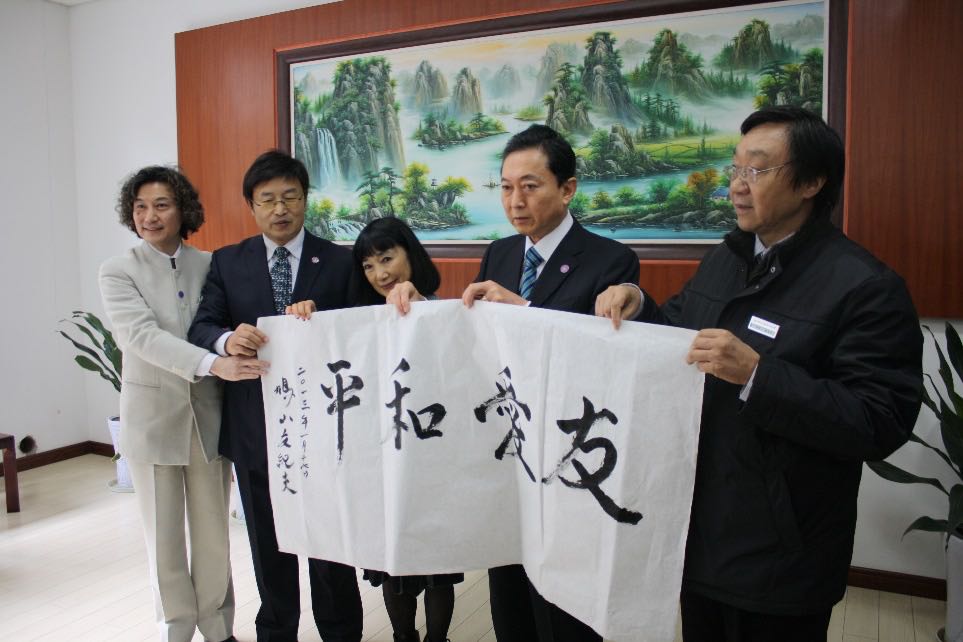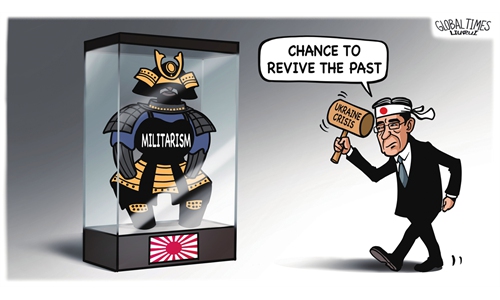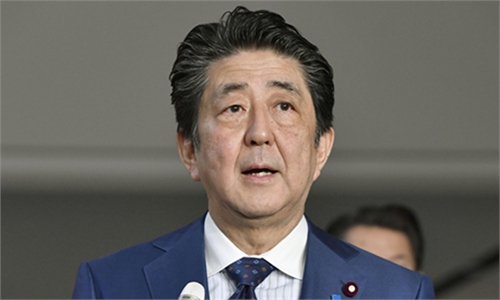Three former Japanese prime ministers I received at the memorial hall of the Nanjing Massacre expressed wishes for peace and friendship: curator

Zhu Chengshan (right) and former Japanese Prime Minister Yukio Hatoyama (second from right) Photo: Courtesy of Zhu Chengshan
Former Japanese Prime Minister, Shinzo Abe, died after being shot on Friday while delivering a speech while campaigning for the ruling Liberal Democratic Party (LDP) candidate in the western city of Nara. The news soon gained widespread attention in China due to the suddenness of the incident and the continued attention paid by Chinese people to China-Japan relations.
In the 21st century, Japan has had a dozen prime ministers, including Abe. But today, we shall focus on three former Japanese prime ministers whom I received when I served as curator at the Memorial Hall of the Victims in Nanjing Massacre by Japanese Invaders. They are Tomiichi Murayama, Toshiki Kaifu, and Yukio Hatoyama who are friendly toward China.
On the afternoon of May 24, 1998, former Japanese Prime Minister Murayama visited the Memorial Hall of the Victims in Nanjing Massacre by Japanese Invaders. As the curator at that time, I provided him with an explanatory introduction that lasted for nearly an hour, giving him detailed introduction of the historical facts about the Nanjing Massacre, and he intently listened.
During the visit, he said that "the Japanese army's cruel atrocities were so appalling. We must seriously realize that the aggression brought unbearable suffering to the Chinese people." He also wrote in the visitor's book after concluding his visit that one should learn from history.
Murayama is the first former Japanese prime minister to visit the Memorial Hall of the Victims in Nanjing Massacre by Japanese Invaders. He is also the first Japanese politician to acknowledge and reflect on Japan's war of aggression.
Two years later, on September 18, 2010, Murayama and I shook hands for the second time at the Museum of the War of the Chinese People's Resistance Against Japanese Aggression near Lugou Bridge in Beijing. Back then, the Memorial Hall of the Victims in Nanjing Massacre by Japanese Invaders had been commissioned by a Japanese friend to bring the exhibition "August 15 by a Japanese cartoonist" to the Museum of the War of the Chinese People's Resistance Against Japanese Aggression. Murayama was also invited to come to Beijing from Japan to participate in the exhibition's opening ceremony.
It's a great honor for me to have cut the exhibition opening ribbon together with Murayama and the then curator of the Museum of the War of the Chinese People's Resistance Against Japanese Aggression, Shen Qiang. In the three days that followed, I had five close encounters with Murayama. The silver-haired Murayama had long eyebrows and a very amiable appearance. He once asked me: "Mr. Zhu, guess. How many years have I had long eyebrows?" I thought about it and said, "About 50-60 years." He said, "My long eyebrows have been there since I was born. It has been more than 80 years." We talked happily as though we were family.
The second former Japanese prime minister I received was Kaifu. It was on the morning of August 19, 2000, and I also gave him a detailed explanatory introduction. In the hall, facing the historical photos that I introduced, he kept nodding thoughtfully. When he saw bones in the "wan ren keng" or the "pit of ten thousand corpses," he asked if it was a massacre site back then. I replied, "This place is called Jiangdongmen. It is one of the sites of the Nanjing Massacre and one of the places where the bodies of the victims were buried."
After the visit, he said, "My heart now aches. History must never repeat itself. The people of Japan and China should join hands and work together for peace in Asia in the 21st century." At end last of the exhibition hall, he wrote in the visitor's book of the memorial hall: "The 21st century is a century of peace." The 11 big Chinese characters expressed his mood at that time and his feelings after visiting the memorial.
On January 17, 2013, I received former Japanese Prime Minister Hatoyama. In the reception room of the memorial hall, I briefly introduced the purpose and history of the memorial hall. Hatoyama thanked me for taking time out of my busy schedule to receive them. He said his friend, Wu Rujun, Nanjing's foreign cultural exchange envoy and cultural celebrity, told him that he should visit the memorial hall. He visited the hall with his wife, the then chairman of the Japan-China Association, and others. He also noted that it had been his seventh trip to China. Just now, I was sitting in the car and saw a tall, white marble statue in the memorial hall from a distance. The statue, the depiction of a woman holding a dove of peace in her hand was very beautiful, which touched me." He said his name had the character for "dove," so he held special feelings for the image of the dove.
In the historical materials exhibition hall stands a replica of the tall but collapsed Zhongshan Gate city wall in Nanjing. I pointed to a historical photo on the explanatory card and said to Hatoyama, "The scene restored here is based on this. It was copied from a historical photo." Hatoyama asked, "[This is] The Japanese army that attacked Zhongshan Gate?" I replied that [It is] The 16th Division of the Japanese Army. The head of the division named Kesago Nakajima." Hatoyama asked again, "Where are they from in Japan?" To which I replied, "Kyoto, Japan." I pointed to some newspapers on the exhibition board which clearly stated that the Japanese Army has brutally killed scores of people in Nanjing with exact figures. These newspapers included The Tokyo Nichi Nichi Shimbun and Osaka Mainichi Shimbun among others.
Hatoyama asked how many foreigners lived in Nanjing at the time and what the estimated population of Nanjing had been. I gave him a few numbers: 39 foreigners lived in Nanjing at that time. They came from the US, Germany, the UK, Denmark, Russia, and other countries. They were professors, doctors, businessmen, missionaries, and diplomats. While they had different occupations, they were there to fulfill international humanitarian obligations. At the beginning of 1937, the population of Nanjing was 1.016 million. As the Japanese army occupied Shanghai, the Kuomintang government moved to Chongqing, and some citizens in Nanjing who had the ability to flee left Nanjing. But on the eve of the fall of Nanjing, more than 500,000 citizens were still stranded in Nanjing, with more than 100,000 people having gone to Nanjing to defend the city. Back then, Nanjing had a population of more than 600,000.
In one of the corners of Peace Park, under the tall statue of the Goddess of Peace, there is a ginkgo tree that's about 20 years old. We asked Hatoyama and his wife to cultivate and water it as a commemorative tree for this visit to the memorial hall. This was also the wish of Hatoyama and his wife. In Hatoyama's own words, he hopes to cultivate a tree of peace.
When the visit neared its end, I invited Hatoyama to write an inscription for the memorial hall. He picked up a writing brush and wrote four powerful characters: "Friendship and Peace" on the rice paper prepared in advance. At the time of the signing, I found that he had changed one character in his name to you, meaning friend in Chinese. When I asked him if it was intentional, he nodded in confirmation. It turned out that what he wanted to express was being a friend of the Chinese people.
According to reports, before his visit to Nanjing, on November 13, 2013, Hatoyama had also been invited to the City University of Hong Kong where he gave a keynote speech on "My Vision for the East Asian Community."


